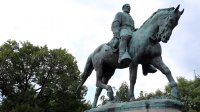When Controversy Hits Your Community
In Virginia, educators say the groundwork for addressing student responses to the recent Charlottesville protest was laid in the years before the event.
Your content has been saved!
Go to My Saved Content.On a sunny summer weekend, the reality of a cruel world found us in the foothills of Virginia’s Blue Ridge Mountains. Normally, we’d simply be preparing for a new school year, but this year in Albemarle County, the end of summer became something else entirely when a “Unite the Right” gathering of white nationalists protesting the removal of a statue of Robert E. Lee in Charlottesville, the county seat, clashed with counter-demonstrators.
Three weeks later, our children have filled our learning spaces. They are walking, playing, talking, and studying together in our 25 schools across 726 square miles. Some of those schools sit within blocks of the scenes that made our area a symbol of American dysfunction and discord, while others are so distant and isolated that children may not even feel the connection.
Creating a Resilient Community
The answer to the question, “How do we respond to a tragedy in our community?” lies in the work we have done before tragedy strikes. This will be true for every school. If children are prized, if their needs lie at the center of every decision, if they have true voice, true agency, and true power over their own environment, you will have a learning community that is resilient and able to emotionally support itself.
Our work depends on an understanding and acknowledgement of our community’s past. Charlottesville and Albemarle County have occupied a complex place in national history. From its early days as home to Thomas Jefferson and the University of Virginia to its role in the American Civil War and Reconstruction and later the “massive resistance” movement of the 1950s and 1960s, the area has experienced some of the best and worst of America’s public and hidden histories.
Today, our area is home to both liberal and relatively conservative communities and both highly educated families and ones with minimal formal education. When children arrive in our schools, they bring all the perspectives, values, and understandings of diverse geographic communities—rural, suburban, and urban. We have children who live in poverty and ones who have all the amenities of wealth. Our students speak 91 languages; many of them come from international refugee camps. Ours is a community where opportunity gaps abound, gentrification threatens families, and a legacy of racism is still unresolved.
Albemarle schools had been working to create more resilient students long before tragedy struck on August 12 of this year. We had already developed the Seven Competencies Framework to help address the changing demographics of 21st-century students, for example, and our “All Means All” philosophy was firmly in place, creating the expectation that every child would be treated with full respect by both adults and peers. To support that mission, we had established a strong commitment to trauma-sensitive education that built on our focus on culturally responsive classrooms, and on social and emotional learning in general. Those efforts led directly to this year’s commitment to providing focused team support in our urban ring schools for social, emotional, and academic development. We also already had a plan in place for our high schools to engage in a grant from the National Writing Project to implement project-based learning to deepen students’ understanding of the meaning of various local historical memorials and monuments.
You can never be entirely prepared for events like the deadly protests that occurred in our community—reality will always have the capacity to surprise and shock—but in Albemarle we had done the hard work that laid a foundation of resilience in our students. We are incredibly fortunate that our educators were able to draw upon the trauma-sensitive work we began last year, which has been critical to allowing our opening days this year to be as healthy and happy as can be expected for everyone.
To support our staff, we aggregated resources from some of our previous and newer work on how to talk to students about tragic or violent events. These resources include some that are specific to Charlottesville as well as materials for all grade levels on teaching controversial issues and creating a kinder classroom.
In high schools, the point when students received their one-to-one laptops doubled as a safe time for students to talk with their teachers and to each other. Students at one middle school began by spending four and a half hours in each of the first four days working on issues around humanity, community, citizenship, and responsibility. In our elementary schools, educators capitalized on our existing responsive-classroom model, which has built-in social and emotional conversation time and established routines for safe and open conversations with children.
As we have listened to our young people—from 5 to 18 years of age—gather and talk together in the opening days of school about what they want their school communities to be like, their words represent the best of who we are as humans. One young man in a middle school classroom said it best: “If we really believe in and do the things that show respect for each other, no one gets left out.”
This has been a very difficult time for us, but it has also showed us that our belief in moving education forward is making a real difference.
